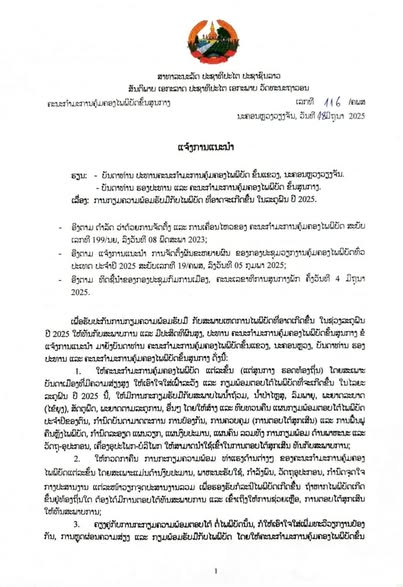KPL
The Lao government has issued comprehensive guidelines to strengthen preparedness and response to potential disasters during the 2025 rainy season. The Central Committee for Disaster Management has called on disaster management committees at all levels—from central to village—to remain alert, particularly in high-risk districts.

(KPL) The Lao government has issued comprehensive guidelines to strengthen preparedness and response to potential disasters during the 2025 rainy season. The Central Committee for Disaster Management has called on disaster management committees at all levels—from central to village—to remain alert, particularly in high-risk districts.
Committees are instructed to prepare for floods, landslides, storms, dengue fever outbreaks, plant pests, seasonal illnesses, and other threats. They must review and update disaster response plans, establish clear prevention, emergency response, and recovery strategies, and ensure adequate resources, including budgets, personnel, vehicles, equipment, and essential supplies.
Disaster committees must assess their readiness by checking available funds, staff, vehicles, and materials. Each level must set up designated coordination centers for specific tasks and establish an overall disaster response hub. In the event of a local disaster, response teams must act immediately to provide emergency assistance.
Along with emergency response, there is a strong emphasis on prevention and disaster risk reduction. Local committees are required to develop risk reduction plans and sector-specific emergency plans and to conduct regular simulation drills.
The agriculture and forestry sector must monitor rainfall and water levels at 29 Mekong River stations. It must issue alerts through radio, television, SMS, and online channels, especially for high-risk areas. Authorities are tasked with checking water pumps, irrigation systems, crop varieties, and livestock conditions and providing timely information to farmers.
National defense, security forces, youth groups, and mass organizations must also be ready. These groups should prepare rescue equipment, vehicles, and trained personnel and conduct emergency drills.
The industry and commerce sector must oversee dam operators to ensure safe water discharge, preventing damage downstream. It must also guarantee a stable electricity supply during emergencies.
The technology and communications sector must ensure mobile and internet connectivity in at-risk areas. The education and sports sector is expected to inspect schools, protect learning materials, and teach students about disaster safety.
The health sector must prepare mobile health units, water and sanitation services, disease prevention tools, and emergency medicines.
Public works and transport authorities must inspect and repair roads, bridges, sluice gates, and drainage systems to avoid blockages and flooding.
The Prime Minister’s Office will evaluate the Central Committee’s proposals and recommend coordination measures to the Government. The Ministry of Foreign Affairs must be ready to coordinate international and regional assistance, including from UN agencies.
The Central Propaganda and Training Board must ensure timely and accurate information is shared through digital media and must actively counter misinformation. All sectors are required to monitor alerts from the Meteorology Department and act immediately on any warnings, especially by informing vulnerable communities.
Lastly, central and local ministries must improve coordination, ensure transparent reporting in all disaster phases—before, during, and after—and submit consolidated reports to higher-level committees for prompt decision-making and action.
KPL